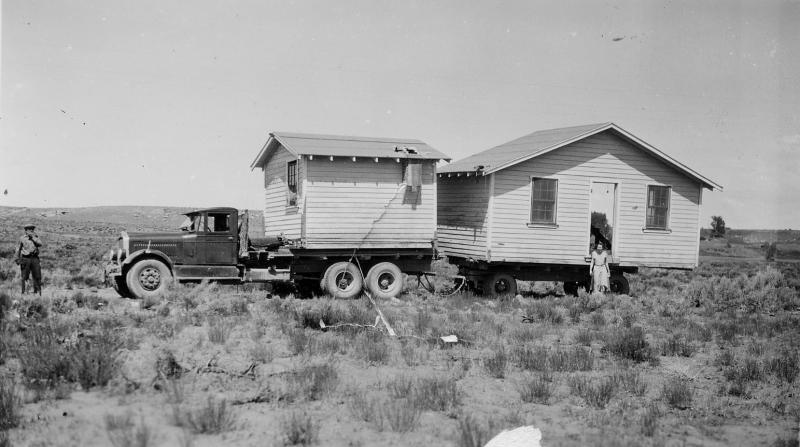Industry Economic Human Landscape
Boom and Bust
In Special Collections
At the Utah Museum of Fine Arts
Related Resources
In Special Collections
The Charles Neal collection, the Ray Yourdon collection, and the Gilsonite ™ Mining photograph collection, document the swift changes that both mineral wealth -- and depletion -- brought to the region. In the late nineteenth century, a large vein of gilsonite™, located on the Uintah-Ouray Reservation, was unearthed by Samuel Gilson. Gilson was not the first to extract this rare mineral but he is remembered for his innovation in developing potential applications for it (including paint and insulation) and his ability to market those applications to corporate interests. These corporate interests pressured politicians to defraud the Ute Indian Tribe of 7000 acres of tribal land in which the mineral was located.
As additional deposits were discovered, and further uses for the mineral developed, the towns of Dragon, Watson, and Rainbow thrived as stops on the new railway built to transport the mineral. However, these stores of gilsonite™ were soon depleted and mining operations moved north to Bonanza, Utah; Dragon, Watson, and Rainbow now stand only as ghost towns. Bonanza continues to be one of the only sites of industrial, high quality quantities of gilsonite™ worldwide; the mineral now has hundreds of applications, from oil and gas well drilling to asphalt paving.
Note: This mineral is commonly referred to as gilsonite™, although that term is trademarked by the American Gilsonite Company (it was sold to them by Sam Gilson). The geologic name is uintaite.
Despite the initial Uinta Basin Railway being torn up to make way for cheaper truck transportation, the new Uinta Basin Railway project approved in December 2021 for construction will again connect Bonanza to national railway lines. The wealth of crude oil and gilsonite™ in the area has led to another boom and the need for enhanced transportation of these resources out of the region. This project is still being fought by Utah-based environmental organizations.
At the Utah Museum of Fine Arts
Arthur Rothstein, A Ghost Town, Rhyolite, Nevada, 1940. UMFA2012.13.39.
Arthur Rothstein (1915-1985) worked for the U.S. government’s Farm Security Agency from 1935 to 1940 to document displaced laborers and farmers and the environments where they lived across the United States. The resulting corpus reflects the devastating economic conditions Americans faced during that period. In Rothstein’s photograph, a woman stands in the ruins of a building in Rhyolite, Nevada. The structure’s façade gives way to a vista made possible by the absence of the building’s rear wall. Dry scrub plain rises into gently sloping hills in the distance, the parched landscape as inhospitable and seemingly uninhabitable as the crumbling man-made structure.
U.S. Fuel Company was headquartered in Hiawatha, Utah, after coal was discovered there in the early 1900s. When stores of coal began to decrease, the town was gradually abandoned and disincorporated in the early 1990s. This Christmas card was issued by U.S. Fuel Company in 1923.
Utah Abandoned Mine Reclamation documents how the State of Utah reclaims abandoned mines that have been exhausted of natural resources, deserted because of low grade ore, or vacated for other reasons. (Seth Button)
The End of the City of Bingham Canyon explores a once vibrant town later demolished to make way for expanding mine operations. (Brian Leech, PhD)
Risk and Reward: The Western Uranium Boom, 1948–1970 showcases the voices of individuals impacted by the discovery of uranium in Utah. (Nate Housley)
What's 'Mine' is Bought
Lesson Plan, 8th - 12th Grades, American History 11+ AP + IB
Nate Milch
This lesson is meant to have students think deeper about how the economy influences the ways we live and perceive the importance of certain things, specifically with the example of mining in the West and the worth we give the land in terms of monetary value. Through using collage as a medium to explore the themes of mining and the economic influences of it, students can draw parallels between the extraction of their collage materials from their sources to the extraction of materials from the earth and consider how the ways they manipulate those materials change their value.









